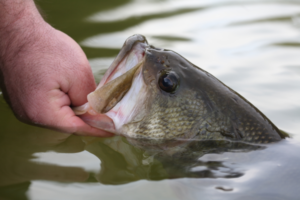Find the Thermocline for Productive Late Summer Bass Fishing
from The Fishing Wire

Find thermocline for summer bass
The hottest two-month stretch of the year is here and largemouth bass anglers must make adjustments if they want to continue catching fish during the challenging dog days of late July through August.
Locating the depth of the thermocline is the first priority for bass anglers fishing Kentucky’s major reservoirs in late summer, as well as elsewhere throughout the South. Longer days and the higher sun angle of late spring warms the upper layers of a reservoir. By summer, the lake stratifies by temperature. The thermocline is the zone where the warmer upper layers mix with the oxygen-depleted, colder water layers below.
There is no dissolved oxygen below the thermocline for fish to breathe, so it is a waste of time fishing below it. The Louisville District of the U.S. Army Corps of Engineers provides a helpful page at https://www.lrl.usace.army.mil/Missions/Civil-Works/Water-Information/Water-Quality-Data/ that provides the location of the thermocline. Click on the lake you are interested in and select “Most Recent Lake Profile.” The right-hand column shows the amount of dissolved oxygen in the water. The thermocline is the depth where the dissolved oxygen falls below five.
Water fertility and clarity play a role in the location of the thermocline. This week, the thermocline on mid-depth hill-land reservoirs with relatively clear water, such as Green River, Barren River, Rough River and Nolin River, is about 15 feet.
“Some clear lakes like Cave Run have a deep thermocline at about 20 feet,” said Mike Hardin, assistant director of Fisheries for the Kentucky Department of Fish and Wildlife Resources. “The water at that depth is about 73 degrees right now, more comfortable water for bass. At a lake like Taylorsville, a shallow, fertile lake, you don’t have that cool water option as the thermocline is only 10 feet deep.”
Smart bass anglers fishing the mid-depth reservoirs should probe structures from 10 to 15 feet deep, such as points that extend out into the lake, submerged humps or channel ledges. Those fishing a shallow lake like Taylorsville should look for ambush cover just above the thermocline, such as a sunken tree-top, stump field or in flooded timber.
“Do not forget the basics of bass fishing,” Hardin said. “Bass hang out where there is food. Shad like to follow channels. Points near the channel or any cover along the channel ledge are money spots at this time of year.”
Jigs slowly crawled across the point or along the channel ledge draw strikes. Points with stumps or chunk rock hold the most fish. Jigs in the peanut butter and jelly color, black and blue or green pumpkin make good choices.
Boat positioning is important to keep a jig crawling on the bottom and across those points, channel ledges and humps. Some anglers use marker buoys to visualize the sunken structures.
Deadsticking a 7- to 10-inch straight-tailed worm rigged on a ¼-ounce Shakey head and cast on the point, channel ledge or hump is a technique to try if all else fails. After the lure reaches bottom, reel in the slack and let the worm sit there and wiggle. Occasionally squeeze the rod handle to impart a slight action to the worm. If no takers, reel it in about five feet and try again. Bass that ignored everything in your tackle box will often hit this presentation in late summer. Green pumpkin, junebug or plum glitter are productive worm colors.
Largemouth bass sometime suspend over the point, ledge or hump and ignore lures worked on bottom in late summer. A swimbait works well for suspended bass.
Pearl-colored swimbaits with shades of gray, blue and light purple work well. Fish the swimbait just above the point, ledge or hump with a swimming retrieve, stopping occasionally to let the lure fall. Bass often strike a swimbait on the fall at this time of year. Use the lightest weight you can.
It is hot and finally dry. Make the correct adjustments and continue to catch largemouth bass through the hottest stretch of the year.
Author Lee McClellan is a nationally award-winning associate editor for Kentucky Afield magazine, the official publication of the Kentucky Department of Fish and Wildlife Resources. He is a life-long hunter and angler, with a passion for smallmouth bass fishing.
Kentucky Fish and Wildlife news releases are available online at fw.ky.gov